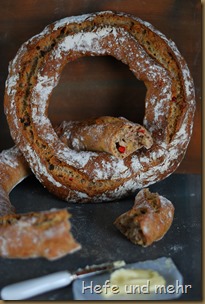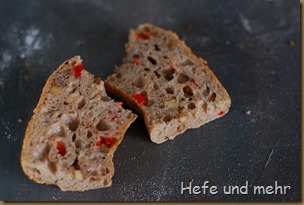 The last time I phoned my sister, she told me about a “Baguette” she ate in a cooking class some days ago. She liked the combination of hot pepper, walnuts and whole spelt flour, but the bread had a very thigh and doughy crumb. So I wrote down the recipe and promised to build a better recipe. For that I had to change nearly the whole recipe.
The last time I phoned my sister, she told me about a “Baguette” she ate in a cooking class some days ago. She liked the combination of hot pepper, walnuts and whole spelt flour, but the bread had a very thigh and doughy crumb. So I wrote down the recipe and promised to build a better recipe. For that I had to change nearly the whole recipe.
I take out the egg from the formula (no egg is needed in a baguette), but add a good deal more water but much less yeast. I reduced the amount of walnuts only a little bit for a better balance between bread and nut and added some chopped sweet red pepper for the good look. The amount of hot pepper should be adjusted by the personal taste, the amount of Habenero I used brings the recipe definitely to the hot side. If you want a milder version I would decrease the hot pepper and use more sweet pepper instead.
I kneaded the dough as I would knead a baguette dough and in the end I was rewarded with a soft but not sticky dough. It was easy to form some rings out of it. And after a propper fermenting and proofing time (something the original recipe omit) I was rewarded with a great aromatic bread. The Khorasan wheat, which I used instead of Spelt, gives a sweet nutty flavour to the dough which goes very well with walnuts and hot pepper. And the crumb is nicely open, especially when you consider the high amount of whole grain flour. A perfect bread to bring to a BBQ or to eat as a side with a summer salad!
Hot Walnut Ring with Koharsan Wheat
yields 2 Rings
Dough
- 200g Koharsan wheat, freshly milled (or whole spelt flour)
- 350g flour Type 550
- 360g Water
- 10g Salt
- 5g fresh yeast
- 100g Walnuts, roasted and chopped
- 30g sweet pepper, finely chopped
- 6g hot pepper (Habanero), finely chopped
Mix flour with water and let it rest for at least 20 min (autolysis). Now add yeast and salt and knead for 5 min by folding the dough from the outside of bowl into the middle Let rest for 60 min again, then let the dough ferment the dough for 12-24 hours in the fridge.
The next day heat baking stone in the oven to 250°C.
In the meantime divide into two equal pieces and preshape into boules. Rest for 10 min. Now press a hole in the middle of the loaves using your fingers and widen it to form a ring with 30 cm diameter.
Proof for 60 min. Because you can bake only one ring at a time in a normal oven, but the second ring into the fridge after 20 min of proofing to slow down fermentation.
Slash circularly and bake the loaf on the hot stone for 25 – 30 min at 250°C with steam, until the crust is golden brown. Repeat the procedure with the second ring.
I sent this entry to Yeastspotting, Susans weekly showcase of yeast baked good.
Deutsch



Hallo Stefanie, das Rezept hört sich super an! Meinst du ich kann statt Kamut/Dinkel auch Emmer benützen?? Bzw. welches mehl lässt sich am besten gegen Emmer eintauschen?? Danke!
glg
@Alexandra: Das sollte gehen, allerdings wird die Krume wahrscheinlich ein wenig dichter werden. Ich verwende Emmer, Kamut und Einkorn e am liebsten in Kombination mit Weizenmehl. Dadurch verbessern sich die Teigeigenschaften und das Brot wird auch nicht so teuer. Am ehesten würde ich Dinkelmehl mit Emmer vertauschen. Falls du nach Inspirationen suchst, Micha hat schon einige Emmerbrote gebacken!
Huhu,
der klingt ja umwerfend lecker… vielleicht muss ich nachher nochmal kurz ne Kleinigkeit einkaufen gehen……
LG, Stephi
Kamut ist doch ein Schätzchen. Schmeckt super und macht auch noch eine tolle Krume! Oder? Den mögen wir :)?
@Micha: Ja, den mögen wir 😀